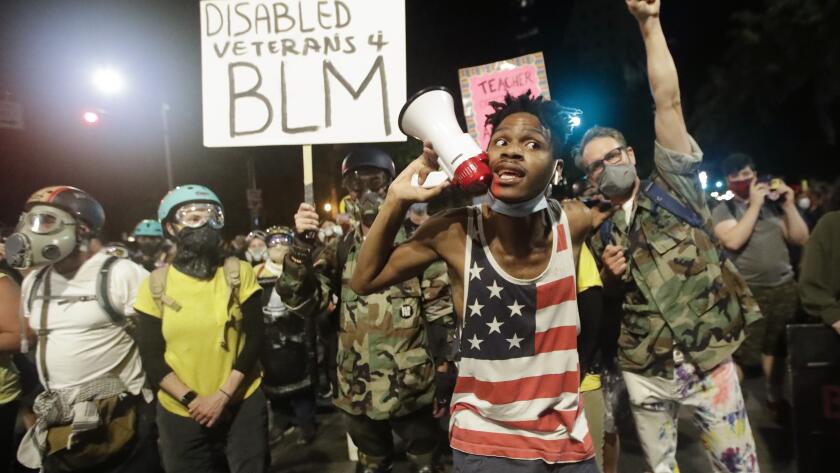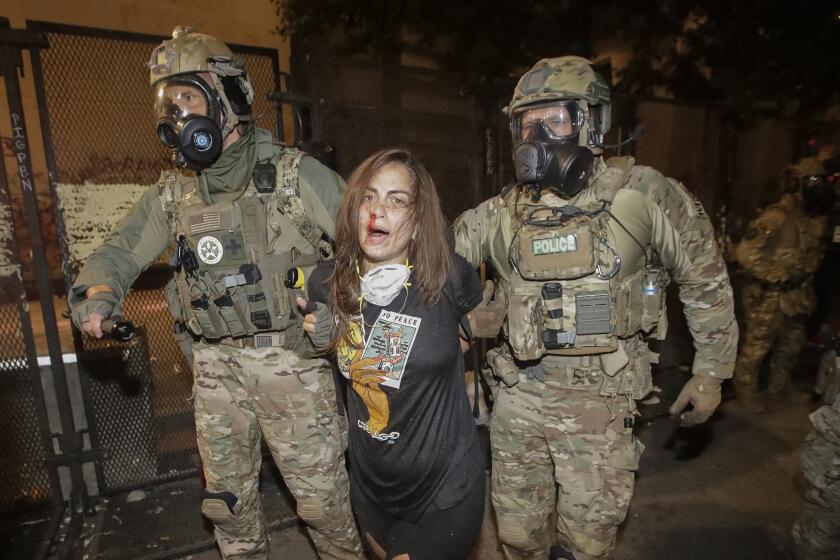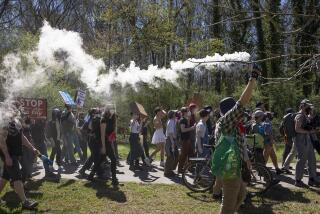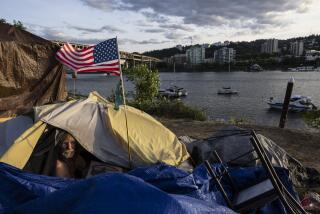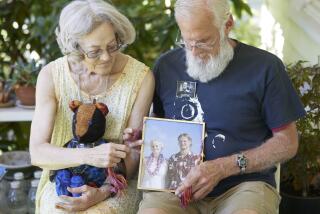As protests against federal agents grow in Portland, Black activists worry their message is getting lost
Black activists say they are concerned that the original goals of the protests in Portland, Ore., are being co-opted by some white protesters in clashes with federal agents.
PORTLAND, Ore. — As the sun was setting and the crowd of protesters outside the federal courthouse grew larger, a loud voice echoed from the front lines of the demonstration.
“Don’t tell me how to protest,” a young Black man shouted at a white protester. “Don’t tell me what to do.”
Though it’s unclear what prompted the dispute, the white protester backed down.
Such confrontations have played out several times during protests at the Mark O. Hatfield U.S. Courthouse in downtown Portland and serve as just one example of how internal divisions among protesters have Black activists worrying that their demands for police reform and equality have been drowned out.
Black protesters in Portland — where the population is 77% white — said many protest groups at the federal courthouse, including the Wall of Moms, teachers and healthcare workers, have been receptive to shifting the focus back on amplifying Black voices and their fight against police brutality, but that some still worry their cause of racial justice may be eclipsed by the presence of federal agents and some of the disruptive tactics protesters have been engaging in.
“I’m happy some people are coming out, but not many people have been asking the Black community what they need,” said Anita Randolph, a 33-year-old neuroscientist at Oregon Health and Science University and a Portland resident.
The actions of federal law enforcement officers at protests in Oregon’s largest city are raising the prospect of a constitutional crisis.
“The feds have been here since early July. Where were people then?”
Randolph has been dropping off supplies and first aid kits since protests erupted in Oregon’s largest city in May. She said as the protests grew larger, some white demonstrators have been centering themselves as the focal point of the protests and as a result are co-opting the movement and diverting attention away from Black protesters’ original demands.
Other Black activists agree.
They point to examples such as the viral photo that has been given the moniker “Naked Athena.”
To many Black — and white — protesters on the front lines, the photo might have spoken to protesters’ resistance against the presence of federal agents, but they worried it diverted attention from the overall issue of institutionalized racism that Black communities in Portland and elsewhere face and the changes activists have been demanding.
Those goals include defunding the police and reinvesting that money into more resources for the Black community to improve education and fight income inequality.
“I’m there to get the message out that Black lives matter. The focus is shifting because some people are down there because of the federal presence and it’s distracting from the bigger issue about racial equality,” said Sarah Maginnis, a white protester.
“It’s confusing for some white protesters because they don’t know who to listen to and who to turn to. There’s no clear leadership.”
The 29-year-old Portland resident said the original purpose of the protests has been lost in part because of federal agents’ excessive use of force on protesters and the young and mostly white anti-government protesters who provoke them.
Those protest tactics and subsequent nightly standoffs between federal agents and protesters have resulted in internal rifts among different groups.
But regardless of differences over protest techniques, Maginnis said she believes one way white protesters can still be an ally toward the Black community is to put themselves between federal agents and Black protesters when those standoffs occur.
Randolph and other Black activists agreed that the Black Lives Matter cause is being lost because there is no clear leadership as far as Black activist groups that are organizing people to protest at the federal courthouse.
The decentralized nature of the protest movement and such internal divisions have made it hard to come up with solutions, Randolph said.
“We are going to need a unified front if we are going to survive,” she said. “We are going to need to talk about the issues that we are facing and come up with real solutions.”
While demonstrations have been ongoing since George Floyd‘s death in Minneapolis police custody in May, the number of protests had been dwindling for some time, even after President Trump sent federal agents to Portland this month.
Several factors sparked the resurgence of protests, including the shooting in the face of an unarmed protester by a federal agent. The protester was badly injured. In another incident, two agents in camouflage military uniforms were seen on video whisking away a person into an unmarked vehicle.
Now the protest movement outside the federal courthouse has morphed into what appears to be a sustainable, organized and functioning resistance that includes a wide array of grievances — the most recent being an end to the presence of federal officers, which many protesters see as a trampling of people’s civil liberties.
The nightly standoff between protesters and federal agents has been playing out in predictable ways. As the sun sets, peaceful protests begin, with Black activists giving speeches and chanting “Black lives matter.”
But in the early morning hours, young and mostly white protesters begin their nightly ritual of setting off fireworks and throwing bottles across the protective fence that has been erected to protect the federal courthouse, prompting federal agents to come outside and deploy volleys of tear gas, rubber bullets, flash-bang grenades and other munitions at protesters — including those who have been peacefully protesting.
The standoff usually ends about 3 a.m., with plumes of white tear gas billowing in the sky as agents retreat back inside the courthouse.
That pattern was generally repeated late Monday into early Tuesday, although the crowd was smaller than on previous nights. The standoff also did not last as long, but federal agents persisted in deploying tear gas, flash grenades and other munitions to disperse protesters.
Alaysia Atkins, a 24-year-old Black activist in Portland, said she understands why the message of the protests evolved, but she hopes protesters continue to hold local politicians accountable.
“I’ll be out here for 365 days if I have to,” she said. “I’m fighting for my life.”
Other Black activists said they viewed this moment as an opportunity.
Teressa Raiford, executive director of Don’t Shoot Portland, a Black-led social justice and advocacy nonprofit, said Trump’s deployment of federal officers has spurred large amounts of donations that will help accelerate change not only for the Black community in Portland but throughout Oregon as well.
“So many people have been donating money to help us get the resources we need,” she said.
“Black leaders are doing a lot of behind-the-scenes organizing,” Raiford said, pointing to several class-action lawsuits filed in collaboration with others against the city of Portland for its use of tear gas and other munitions on protesters. Such collaboration enabled her nonprofit to file a lawsuit against the city on June 5.
A temporary agreement was reached on June 27, in which the Portland Police Bureau agreed to limit its use of less-lethal devices.
“Litigation matters. I’m hoping we can get more people to sue for damages,” she said. “So many people have been harmed by the assaults and excessive force that is [playing] out and somebody will have to pay for it.”
Meanwhile, the Associated Press reported Monday that the Department of Homeland Security is preparing to send more federal agents to Portland — about 50 additional Customs and Border Protection agents — according to an administration official who spoke on condition of anonymity. The official said the plan had not been finalized and it was unclear whether the officers would replace agents already on the ground.
The AP also reported that mayors in six cities — Portland, Seattle, Chicago, Kansas City, Mo., Albuquerque and Washington, D.C. — asked Congress to stop the federal government from deploying federal agents to cities that don’t want them.
Portland Mayor Ted Wheeler and City Commissioner Jo Ann Hardesty on Monday referred to the presence of the agents as a “federal occupation” and called for an immediate meeting with Department of Homeland Security leadership on the ground in Portland and with acting Secretary Chad Wolf “to discuss a cease-fire and removal of heightened federal forces from Portland.”
More to Read
Sign up for Essential California
The most important California stories and recommendations in your inbox every morning.
You may occasionally receive promotional content from the Los Angeles Times.
